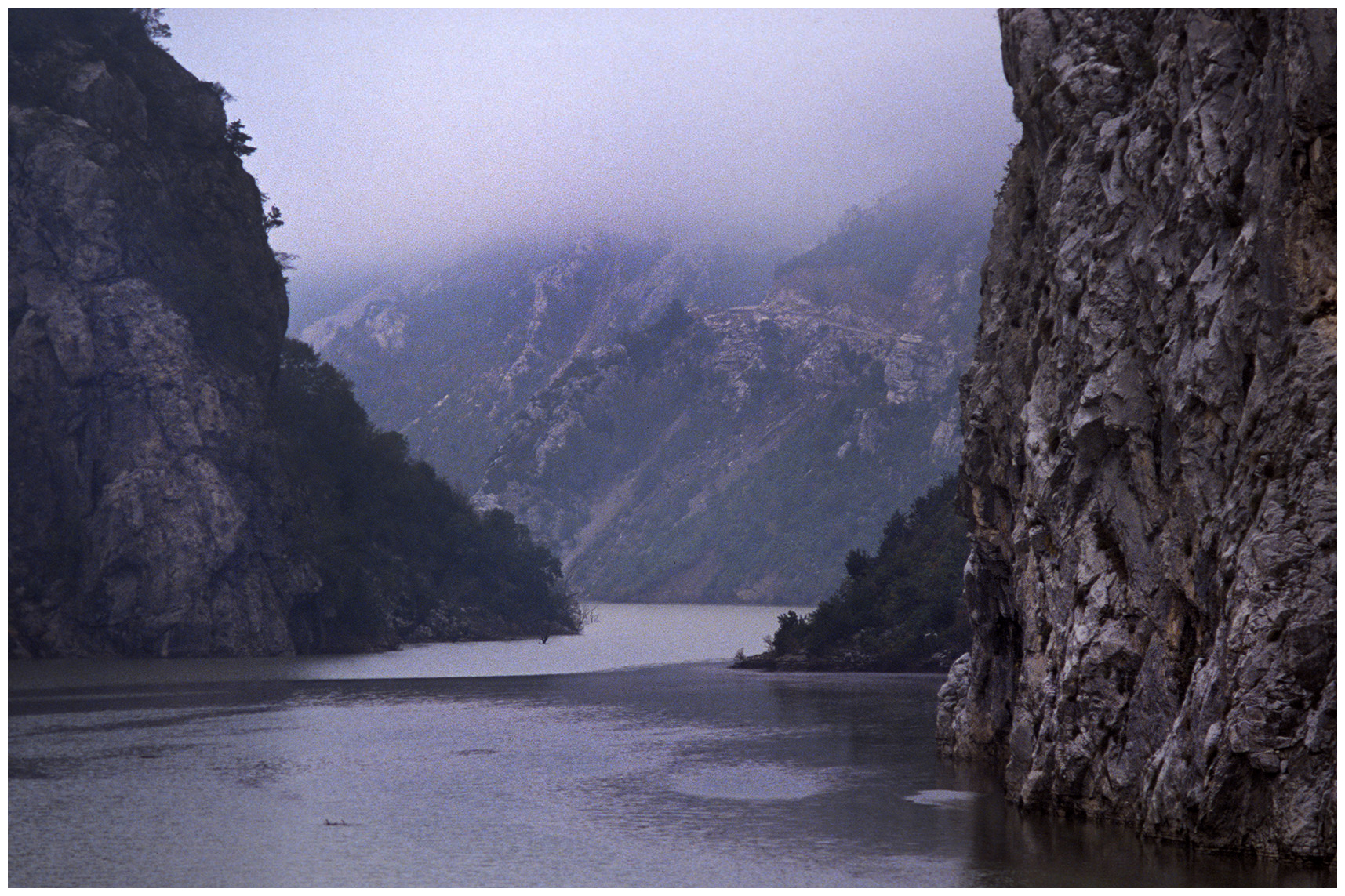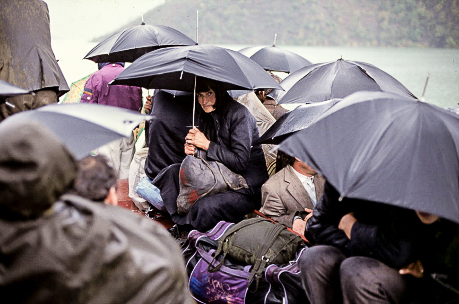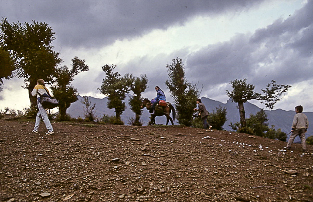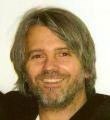
Robert Pichler
Traveling pictures: Remnants of Albanian mountain culture and their changing perception by different audiences
Robert Pichler revient sur sa propre pratique photographique en Albanie du Nord, dans les premières années ayant suivi la chute du régime communiste, pour montrer comment le statut et la réception de ces images, issues d'une région possédant elle-même une « image » bien marquée en Albanie (pauvreté, arriération, violence), changent selon les contextes et les spectateurs auxquels elles sont présentées.
When I started my research on the Northern Albanian customary law (kanun) in 1992, my camera became a constant companion on my travels in the area. Like a diary, photography served to capture my experiences, to depict people, rituals, everyday life, the environment and material culture. In my first publications I used the photographs to illustrate different aspects of rural culture. Back in Austria, I prepared a slideshow with the pictures I had taken in Northern Albania and presented it to various audiences. In Tirana, too, I had once shown some pictures and a film clip to my host family. In doing so, I realized that the pictures triggered very different reactions in different audiences. The response was highly dependent on whom I showed the images, whether people from Albania, students or teachers in Austria or local people from my home village who wanted to hear about my experiences in Albania. What they all had in common was their curiosity about Albania or parts of the country: regarding Albania, there is often little knowledge and many rumors. In this article I want to elaborate on different audiences’ perceptions of the pictures from the Albanian mountains, and the dilemmas I faced when I tried to put the visible phenomena into an analytical context.
Traveling pictures
By ‘traveling pictures’ I mean that the perception of a single picture can be very diverse. People in one place may see one thing, while those elsewhere see it with different eyes, triggering different reactions. The ‘elsewhere’ is not primarily an issue of locality, but a matter of social strata, age, gender, origin, knowledge, education and finally ideology. It also depends on time; pictures that are rejected at one point may find some appeal after a certain period.((This happened to me when I returned to Albania after 25 years with the photographs I had taken in Northern Albania. I showed these pictures to artists from different fields. Their reactions were not as I had expected; they were deeply impressed by the powerful archaic expression of some of the pictures, and saw it as a reflection of a perishing culture. Some stressed that it was their culture, but found the pictures powerful primarily as aesthetic statements.))
This shows that the perception of images depends very much on the particular gaze of the beholder. If we thus think about the ways in which different groups of viewers look at pictures, it is useful to think in terms of gazes. Peter Burke differentiates between various ‘western gazes’ such as the scientific gaze, the colonial gaze, the male gaze, etc.((Peter Burke borrowed the notion of the ‘gaze’ from the French psychoanalyst Jacque Lacan. On Lacan’s concept of the gaze see Yuanlong Ma: Lacan on Gaze. In: International Journal on Humanities and Social Siences. Vol. 5, No. 10/2015: 125-137.)) (Burke 2001: 125). I borrow this concept from Burke and use it for my own examples by elaborating on the different reactions I received from different audiences to the pictures I took in the Albanian highlands. During my presentations I also learned that the visual images were more powerful than the information I intended to convey. Metaphorically speaking, the images had their own life beyond descriptions and explanations about the depicted phenomena. This is attributable to the fact that visual images penetrate deeply into the unspoken and the subconscious. They also relate directly to mental maps. Mental maps, in the classical definition, do not primarily point to ‘locational information’, but contain information about the qualitative characteristics of the represented object. They contain values and meaning about a given area, region, country or people. This normative charge is an important reason why the concept of mental maps lends itself well to cultural studies and historical inquiry. The mental map approach focuses on how concepts of cultural space are created and manipulated by (world)views and collective representations.((Frithjof Benjamin Schenk: Mental Maps: The Cognitive Mapping of the Continent as an Object of Research of European History (published 2013-07-08). European History Online [http://ieg-ego.eu/en/threads/theories-and-methods/mental-maps/frithjof-benjamin-schenk-mental-maps-the-cognitive-mapping-of-the-continent-as-an-object-of-research-of-european-history])) Historical mental map research, however, has for long neglected visual source material.((Andreas Langenohl: Mental maps, Raum und Erinnerung: Zur kultursoziologischen Erschließung eines transdisziplinären Konzepts, in: Sabine Damir-Geilsdorf et al. (eds.): Mental Maps, Münster 2005 (Kulturwissenschaft: Forschung und Wissenschaft 1) pp. 59 (51–69).)) Addressing mental maps goes hand in hand with the study of prejudice and stereotypes. Prejudices are judgments that are taken against all deliberate judgments and thus link directly to stereotypes that always appear when encounters between ‘cultures’ take place. Stereotypes are particularly striking when visual images concur with mental maps.
The portrayal of archaic rituals
In 1992 I came to Albania with a scholarship that allowed me to stay six months in the country. I carried out my first research on the transformation of the Northern Albanian Customary Law (the so-called Kanun i Lek Dukagjinit) during communism and the modes of its revitalization after the end of the dictatorship. For centuries the kanun ‘operated’ as a system of orally transmitted rules, norms and values that governed the main aspects of social life in the mountainous areas of Northern Albania, Montenegro, Kosovo and Western Macedonia. My research interest was to find out how the communist state intervened into this system of local self-administration and how people in the mountains adapted to the new political conditions. Ismail Kadare’s The Broken April had attracted my attention and inspired thoughts about the clash of cultural norms and values in an area historically characterized by a strong sense of autonomy and resistance against state intrusion. Officially, the kanun had been banned during communism, and modes of self-administered justice like blood feuds were severely punished. However, as I learned from media reports, people resorted again to the kanun as a result of the lack of order in the aftermath of the collapse of the state in 1992. I travelled to the North for the first time to explore the area and to conduct interviews with local people. My trips took me to Mirdita in late autumn 1992, and to Nikaj in autumn 1993. During these trips I took pictures of two rituals: a wedding and a funeral. Later, after my return from the mountains, these pictures became an important source of my presentation about relics of ‘traditional culture’ and their revitalization in Northern Albania. A selection of these pictures serve as source material for this contribution. In addition, I use photos from a trip to the highlands along the river Drin. These components, the rituals and the remoteness of the region were the conceptual focus points of my presentations.
I will first show excerpts from this presentation and clarify in which analytical framework I put these phenomena. Following that, I will discuss the reaction of the different audiences and the dilemmas I faced.
In search of the remnants of the kanun – Northern Albania 1992/93
The journey
I aimed to describe the journey to the highlands in as lively a manner as possible. I depicted the difficult travel conditions, the fact that there were no private cars in communist Albania, that the recently imported cars soon overwhelmed the road infrastructure, and that many people were on the move mostly from the overpopulated mountainous areas to the plains and cities and towns of the country. The pictures illustrated the geographical isolation of many areas of Northern Albania and the difficulty of connecting these areas with the urban centers of the country despite the efforts of the communist regime. I also pointed to the pro-natalist policy and mobility restrictions during socialism which led to the situation that remote mountain areas were desperately over-populated when communism collapsed.
The pictures showed the hardship of travel and the efforts that went with it, but they also gave an impression of my own adventure as the one who took the pictures and participated as a stranger. The boat-trip however, was only the first segment of the journey. I described how we got off at a deserted station and began our long, arduous trip along a steep mountain path to the village. All these stages of the journey were illustrated with pictures.
The Family and the Kinship-Structure
I continued my presentation with a section on family and kinship. In doing so, I stressed the fact that the Northern Albanian highlands are among the regions where extended family households were widespread until after the communist takeover. My aim was to draw attention to the structurally divergent kinship and household formation patterns that existed historically between Southeastern and Eastern Europe on the one hand and Central and Western Europe on the other. I referred to the constitutive features of extended households, such as equal male inheritance, women marrying at early ages, the principle that women move to the household of her husband upon marriage (patrilocality), that authority rests in the hand of the old men (seniority) and that kinship and power is based on the male descent line (patrilinearity). I stressed that this household formation pattern was widespread in many Balkan areas, but Northern Albania was the region in which they have been retained the longest. Notable reasons for this were the prevalence of agro-pastoralism, the weak market penetration and the preserved tradition of local self-rule based in the kanun. The communist regime, with its claim to institutional and legal penetration, banned the application of the kanun and attempted to eliminate the traditional power structures. Among other things, the new government took measures to bring about the division of large extended households which represented the old system. This policy has been broadly successful, which is why large extended households hardly existed any longer in the early 1990s. I used one of the few examples I encountered as illustrative material to explain the organization of labor and the authority of its members from a historical and structural perspective.
The family portrait shows the head of the house (the man with the traditional Albanian headgear, the plis, in the middle) with his three married sons, his daughters in law and his grand-children all living together under one roof.
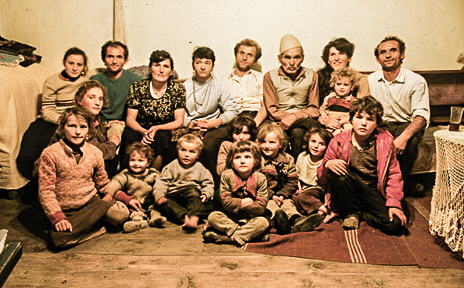
The picture was taken in the living room of the family. I was very warmly received and the prospect that I would make a family portrait caused much excitement. I did not have to contribute much for the arrangement; the most difficult thing was to keep the children static because I wanted to avoid using the flash. I fixed my camera on a tripod and took the picture with an exposure time of 1/15 of a second. The photo was taken with a slide film and thus could not be seen immediately. At that time, I was sufficiently aware of the importance of the photographic image as a unique snapshot: I alone possessed it, because it was me who owned the film and who took it with me and developed it. The family in the photograph depended on my goodwill: they had to trust that I would send them the photos and use them for purposes which did not expose them. The family themselves had no camera at that time.
The rituals: continuities, changes and reinventions
It was undoubtedly the rituals that roused the greatest interest among the audiences who viewed my presentations. I used pictures from two weddings, one funeral and one ‘pacification of a blood feud’. However, I showed the latter only rarely because I deemed it too complex a phenomenon to explain to an audience without specialized knowledge. I usually used two wedding photos in order to illustrate different positions to cultural norms and values. The first picture represented the ‘traditional’ system, and the second signified social transformation and modernization. The crucial difference was that according to the ‘traditional’ system the marriage was arranged and the couple had little or even no personal knowledge about each other. In rare cases it happened that brides had not seen their future husband before the wedding at all. I compared these cases, which represented the old system according to my simple classification, to weddings in which the couple knew each other and the decision for the marriage was taken autonomously. While the woman in a traditional wedding dress represented the example of the old system, the woman in a white wedding dress figured as the representative of the ‘modern’ system.

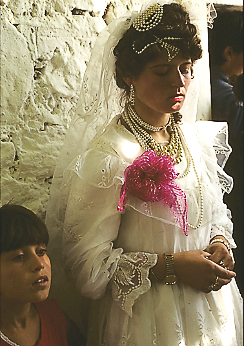
I put the two images side by side and explained the similarities and differences between the two weddings. The women in both pictures are very similar in their pose and expression. Both have folded hands and, conspicuously, both have their eyes closed or downcast. I explained this gesture, and the fact that the bride had to remain silent in public on the wedding day, with the expectation of her submission in the household she was moving into. I then referred to the crucial difference that the bride in the white wedding dress adhered to the ritual for a few minutes, but then opened her eyes and mingled with her bridegroom among the guests. In the ‘traditional’ wedding however, the opposite was the case. The bride, when she was led into the guest room, remained in this submissive posture and had no contact with other people.
In addition, I pointed out that the relatives of the bride did not attend the wedding celebrations. On the morning of the wedding day, the bride was picked up by a delegation of relatives and friends of the bridegroom’s family who took her to his house (alb.: marrja e nuses). The bride was accompanied only by one familiar person. In arranged marriages, the woman thus entered into a totally unknown social environment, as she has no previous contacts, neither with the family nor the friends of her future husband. From the perspective of the bride, the wedding is thus a dramatic and sorrowful event, especially when she moves into a house where she is a stranger, even for her husband. In ‘modern’ weddings however, she is often already familiar with parts of her husband’s family and thus her ‘entering the house’ is more relaxed.
I explained the changes that have resulted in the ‘modern’ wedding with reference to the influence of Communist policy, which aimed at transforming labor organization, fostered education and pursued a policy of female emancipation. These changes, however, were not so fundamental or profound that they had reached all families, as the example of the ‘traditional’ wedding has shown.
I usually finished my presentations with pictures from the funeral. I explained the fact that the burial ritual had survived until after communism with the theory that state and church institutions have only weakly penetrated the remote mountain areas. Additionally, mountain communities not only maintained a strict control over land use and rights, but also preserved a number of rituals that signalled membership, strengthened social cohesion and insulated them from abrupt or indiscriminate influences from the outside. That this ritual had survived despite the decidedly anti-religious policy of the Communist government, which declared Albania an atheistic country, still came as a surprise. The ritual, however, contained no symbolism that referred to the former Catholic affiliation of the people. The execution of the ritual also showed that it must have been practiced only sporadically during the previous years, because only a few old men were able to perform it properly: the others were sometimes insecure and watched the more experienced in order to avoid making mistakes. The young men were not involved at all, but stood at some distance watching the scenery and quietly making jokes about what they saw.
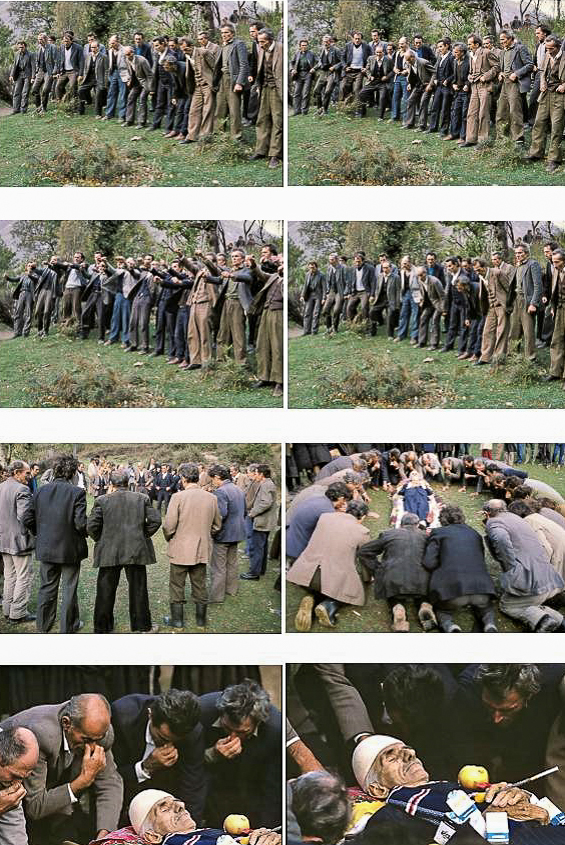
The explanations I provided for the pictures were limited to a few aspects: I pointed out that the ritual was obviously very old, that there existed a few descriptions of it in the travel literature of the 19th and 20th centuries((Robert Elsie has provided one of the few descriptions of this ritual on his homepage. Text and photographs are from the German anthropologists Reimer Schulz, who travelled through northern Albania in 1937 [http://www.albanianhistory.net/texts20_2/AH1937_3DE.html].)); I explained the presence of food and gifts that referred to the idea of a 40-day travel of souls to the afterlife, and I elaborated on the ritual that was originally performed by means of face-scratching, breast-beating, pulling of the hair and other gestures suggesting self-mutilation. I pointed to the intervention of the Catholic Church, who banned the bloody scratching of the face with the argument that such despair ran counter to the belief of resurrection. Women were excluded from this ritual; however, they performed their own lamenting, in the form of the wailing of the dead person’s mother or wife. This took place before the males’ ritual and was also very dramatically performed by a group of old women dressed in black. In my presentation, I combined the images with the original sound, the shouting of the men, which I played along with the pictures. This gave the whole performance an additional momentum, since the body language, in combination with the loud cries of the men, was very impressive. Bledar Kondi provides a detailed description of this performance in his study on the very ritual: « They started to shout ‘A-o-u’ and punctuate it with echoed moans: ‘o, ou; o ho/ha, ho/ha, ho/ha…’ The leader lifts his balled fist to the sky and then all the gjamë-performers beat their breasts. The laceration of their face is mimicked before they press the right nostril with their thumbs, a sign of painful complaint, and then return to a free posture of imitated groaning. They form a circle and repeat the performance. Following this, the men kneel around the corpse and perform the ritual once more. At the end they bow their heads all the way down, as if to say goodbye one last time in reverence. »((Bledar Kondi: Death and ritual crying: An anthropological approach towards Albanian funeral customs. Berlin: Logos 2012: 225.))
In the ensuing discussions the question was often asked how I was able to participate and take pictures at the funeral. I explained this with an observation I made at another funeral at which I was participating. This happened a few years later in the Highlands of Dukagjini, where I conducted field research together with colleagues from different countries. Just as we were on the way to a nearby family, we heard from a distance cries from a funeral ritual. We went there and were promptly invited to participate in the event. The ritual crying of the men was already over, but we were hosted by the family of the deceased and were able to mingle with people in the garden where the dead man was laid on the ground. We then noticed that several men had regrouped at the entrance to carry out the ritual once more. It was clear that this second performance was primarily intended for us, so that we would still get to see the ritual, even though we had arrived too late.
This demonstrated to us that the ritual was also seen as a kind of cultural property; an expression of a particular cultural heritage that was worth presenting to a foreign audience. It was probably of significance that we, as foreigners and ‘guests’, were not ‘only’ tourists, but scientifically interested in the local popular culture. We understood that we should take pictures of the event. That was similar to what I had experienced at my first funeral. I had placed myself far in the background to watch the event from a distance because I felt it was inappropriate and rude to be among the mourners. In my understanding, this was a very personal and intimate event which emotionally concerned those affected, but did not concern me as a stranger. However, the head of the household approached me, pointed to my camera and asked me to take pictures. It became clear that this gesture was also an expression of a cultural self-confidence intended to tell the stranger that there was a culture to be portrayed and conveyed to a wider audience.
Different gazes and the difficulty of controlling the power of images
When I returned from an extended field trip from Dukagjin to Tirana in autumn 1995, I showed my host family excerpts of the footage I had produced from the funeral. My host family lived in an apartment in an old house in the center of Tirana. They were in their early thirties and had two children: a boy and a girl of early school-age. The couple was raised in Tirana and belonged to the typical urban working-class milieu. However, their interest in their country and its ongoing political and social development was very pronounced. I showed them the pictures out of curiosity because I wanted to know if they had an idea about these rituals and, if so, how they perceived the performance. Their reaction was one of astonishment, disbelief and partly even anger. They said that they had never seen such pictures and even doubted that they were shot in their country. It took me some time to convince them that the shots were authentic. However, they still doubted that these rituals were part of an existing popular culture and had not been extinguished by communist intervention. They were well aware that the northern Albanian mountains were a unique cultural region, that the rugged terrain contributed to isolation and cultural seclusion, and that the Kanun of Lekë Dukagjin once played an important role there, but they did not consider the persistence of such rituals to be possible after the end of the communist dictatorship. From their reactions, it became clear that this sort of popular tradition was not deemed to be an element of the ethnic self. In contrast, the ritual was seen as some sort of a temporarily and spatially far distant cultural manifestation which no longer had anything to do with contemporary Albanian culture. Their rejection and anger testified to me that they had difficulties in accepting the fact that I, as a young foreign researcher, had confronted them with an element of ‘their own’ culture which they considered to have already been extinguished. Seen from their perspective, Albania was indeed a desperately poor and economically backward country with a painful transition ahead, but in cultural terms they regarded their people as far more modernized and developed. Their cultural self-conception, however, was also influenced in this particular time by pressing needs and desires, which were oriented towards rapid transformation, connections with the West and the abandonment of all burdensome heritages.
The Albanians, like other citizens of socialist countries, were raised with the idea of a popular culture that contained a clear distinction between what was considered to be remnants of the past and what belonged to the achievements of socialist modernity. The kanun, however, was lent historical credit as a legal code that defended the Albanians against foreign intrusion, but according to the ethno-historical narrative, due to the achievements of the socialist state, it was replaced by a written law that met the requirements of the time. The kanun thus had lost its lived and organic nature, but was reborn as a fact of national imagination and history. It served as a contrasting image of the profound emancipation process initiated by the communist regime.((Ulf Brunnbauer, Robert Pichler: Mountains as „Lieux de Memoires ». Highland Values and Nation-Building in the Balkans. In: r Balkanologie Vol. VI, No. 1/2, Déc. 2002: 96.)) The visual arrival of the funeral ritual in post-communist Tirana dismantled the delineation of the past and reinvigorated a cultural heritage that was regarded as terminated and historical. It was incredible to see how different the ritual was considered to be by the Albanians in the north and by Albanians in the capital. Whereas people in the village re-appropriated it as an element of their local cultural heritage, the people in the city saw no reason to identify with it. On the contrary, they saw it as the arrival of the untamed mountain culture in the city, a cultural heritage that they regarded as backward, primitive and archaic.
After my return to Austria, I prepared a slideshow with my pictures based on the experiences, excerpts and findings from the field trips. My audience was diverse; it ranged from colleagues from the university to teachers from primary and secondary schools and ordinary people from different parts of Austria. After some time, I was invited to give lectures at the pedagogical faculty in Graz. My audiences were teachers who had received training in intercultural education. Their goal was to obtain a better knowledge of the cultures and societies of the Balkans. At this point in time, many refugees were coming to Austria from the former Yugoslavia, where the war had triggered enormous migration movements. It was also a period in which many children of former guest workers were attending school in Austria (a consequence of family reunifications in the 1980s), and teachers wanted to be better prepared with knowledge about the cultural backgrounds of their pupils. Apart from basic information on the history of Southeast Europe, I presented my research from northern Albania. I focused mainly on family issues, on the importance of family and kinship for social security, on gender relations, residence patterns and patriarchal structures with an emphasis on modes of inheritance, the organization of labor and marriage patterns. Special emphasis was also given to processes of state- and nation-building, legal and administrative centralization, the monopolization of power and rule, the nationalization of property, collectivization, migration, and demographic and social transformation.
I used the photographic material from Northern Albania to elaborate on the structural features of the ‘Balkan Family Household’, which I compared with developments in Central Europe from a structural and diachronic perspective. As a historian working in the field of ethnography, I was primarily interested in deciphering the cultural matrix that could be discovered in the observed phenomena. The aim was to capture the complex interplay of historical development, geography, social organization and cultural manifestation, to demonstrate the rationality of these phenomena and their interconnectedness. However, when it came to showing the images from the North, new questions arose. I realized that the images triggered reactions that went far beyond what I wanted to convey.
The photographs of the wedding, information about traditional marriage arrangements, and especially the burial ritual aroused the greatest interest among teachers. If enough time was available, I also talked about the phenomenon of the blood feud that had flared up in Northern Albania after the collapse of the regime. The teachers followed the lecture with great interest: they were eager to get information about a country that was largely unknown to them. In the subsequent discussions I noticed that, although I was indeed able to get people excited about the topic, the attempt to make them understand the complexity of the phenomena was only partially successful. The pictures were mightier than the explanations which I had provided. This was something that caused me to feel uneasy.
Interestingly, comparing the reactions of the Austrian teachers with the Albanian couple, it was notable that the persistence of archaic rituals in the Albanian highland was not considered surprising for the Austrian audience. Austria is itself a mountainous country, and the idea that the mountains preserved old customs and traditions was generally understood. The teachers were intrigued by the funeral ritual, seeing it as a genuine expression of sorrow and pain, an authentic gesture, which, as some said, differed decisively from their own culture of grief (which they judged as non-authentic). In this context, the archaic element was primarily interpreted as something pristine and untainted (by civilization).
On the other hand, the shouting and the gesticulations of the men in the burial ritual conveyed the idea of a pronounced male ferocity which intimidated the predominantly female audience. Overall, the reactions were ambivalent, a mixture of fascination and repulsion at the same time.
The wedding ritual was however primarily judged critically. Again, there was a fascination for the exotic and the archaic, but much more dominant was the imagination of female subordination and dependency. The submissive posture of the bride, her downcast eyes and the fact that she had to move to the household of her husband at the time of her marriage caused significant irritation. This view was reinforced by the lack of inheritance for female family members. The theory of patriarchy provided a scientific confirmation of an impression already developed based on first-hand experiences in dealing with pupils from Turkey and the Balkans. The photographs thus conveyed views of frozen time and the durability of cultural properties.
The reason for this was certainly that I very much focused on rituals. Albanians thus appeared primarily as ritual performers who, despite massive intervention from the communist state, were still partly living in an archaic and superstitious world. As Lutz and Collins point out in their analysis of the magazine National Geographic, the fascination of rituals derives not only from their dramatic enactment, but from the perception that ritual performers are portrayed as encrusted in tradition and living in a sacred and superstitious world. Seen from a secure distance, this ideal view rests on the assumption that rituals contain a kind of distilled history and cultural wisdom.((Catherine A. Lutz, Jane L. Collins: Reading National Geographic. Chicago, London: University of C hicago Press 1993: 90-91.)) However, when the geographical distance is vanishing and cultures come into motion, this fascination easily turns into aversion and anxiety. What ‘we’ admire from a safe distance, and for which we show interest, loses its charm when it is detached from its cultural context and migrates into a supposedly different cultural setting.
By analyzing these discussions, I realized that the aspects of change and transformation that I tried to emphasize in the lecture were barely understood. Much more powerful was the idea that cultural patterns, as exemplified by the patriarchal family, were deeply rooted in societies. The fact that ‘traditional’ weddings still existed after 50 years of communist intervention made the argument of change hardly plausible. The visual images decisively contributed to this understanding.
I also realized that the pictures of the northern Albanian mountains conflated with ideas about the Balkans in general. ‘Balkanism’, according to Todorova, refers to stereotypes about the region that are related to its mountainous character (Balkan is a Turkish phrase for ‘wooded mountain’). According to this view, the Balkan Peninsula therefore has a long and protracted history of ethnic and religious conflicts that relate to its geographical fragmentation. Based on this idea, Todorova suggests that these discussions triggered the stereotype of Balkan people as superstitious, irrational and backward peasant societies.((Maria Todorova: The Balkans: from discovery to invention. Slavic Review 53/2 1994: (453-483) 460-470.)) Todorova, however, also disclosed another widespread stereotype about the Balkans, namely masculinity. According to her, the most crucial difference between the Orient and the Balkan is the purely patriarchal character of the latter. Balkanism is attributed with « uncivilized, primitive, crude and disheveled » representations and is therefore distinctively and singularly male.((Maria Todorova 1997: Imagining the Balkans . Oxford University Press 1997: 14.)) Both aspects are important in this context: the geographical fragmentation, the mountainous character and the male dominance. These are features that dominate the meaning of the photographs, and they are their main signifiers. Although it was never intended to portray Northern Albania as pars pro toto of the Balkan, this generalization in one way or another took place among the beholders. This became clear when discussions revolved around the war in former Yugoslavia which was often erroneously denoted as ‘the Balkan war’. Although there was extensive media coverage of the war, many people did not understand why this war had broken out, and especially why it had lasted so long. Furthermore, people were extremely irritated by the way in which the war was waged, the brutal actions of paramilitaries, systematic rape and torture, expulsion and ethnic cleansing as well as the targeted destruction of cultural monuments. All this was not (and never can be fully) understandable. However, what people ‘consumed’, almost on a daily basis, was the media coverage that continued throughout the war. Images of the war were thus omnipresent at that time.
I discovered that the floating pictures that arrived from the Yugoslav war correlated in a certain way with the pictures I had made in the mountain villages. This referred mainly to the archaic element that was reflected likewise in the ‘pristine mountain culture’ and the brutal war scenarios presented by the media. This was never an outspoken argument, but was indicated by the way in which people spoke about these cultural phenomena. The war was considered the dark, dangerous and threatening side of the pristine, untainted and pure patriarchal culture of the mountains. It was the earthiness of these pictures, their archaic character that entered into a symbiosis with the images of the war in the former Yugoslavia. So it was, in fact, the lack of civilization that served as an explanatory device for the difference between ‘us’ and ‘them’. Thereby, the metaphor of the mountains as a secluded area—isolated from foreign influences, but also from modernization attempts—nourished this notion. Apart from its exotic charm, these cultural sediments, however, were seen as a potential threat. With the outbreak of war and the ‘return of the Balkans to the Balkans’, this backward archaic peasant culture that emanated from remote areas and distant pasts came again into contact with ‘us’.
This was certainly not the only conclusion I drew from the analysis of the reactions to the images I presented to different audiences, but I could not shake the thought or feeling that the visual images were too powerful a medium to handle in an agreeable manner. I eventually decided to skip the pictures entirely. 20 years later, when I went to Albania again, I took the photos to show them to an Albanian friend. A well-known artist, she was very impressed by the expressive power of the images. Today, not many people live in the northern Albanian mountains; many have migrated to the cities or abroad. The immigration of the northern Albanian peasants to the city is no longer a big issue. The funeral ritual, as I described it 20 years ago, no longer exists, according to an informed Albanian colleague. Weddings are still celebrated, but no longer according to the old pattern. The threat has therefore disappeared for the urbanites, and peasants who moved into the city have probably forgotten the tradition they were once proud of. The artist, however, is rediscovering the treasure that lies in these now historical pictures. Her gaze is different. She commented on one of the pictures from the funeral:
« A coffin crossing the stream! Is it empty or full? It must be weightless, since that step of the man carrying the coffin feels so lightly and rightly nailed into the foothold of the rock, as if a butterfly had stopped to fuel from the mouth of a flower. The coffin is weightless but the whole picture is so charged with weight, you feel like you have swallowed a grey cloud…« ((Edit Pula is a painter, curator and art manager in Tirana [http://editpulaj.com/Home.htm].))
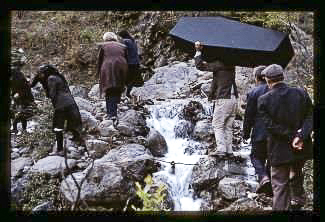
Bibliographie
Brunnbauer Ulf, Pichler Robert, 2002, « Mountains as ‘Lieux de Memoires’, Highland Values and Nation-Building in the Balkans », Balkanologie VI, 1/2, p. 77-100.
Kondi Bledar, 2012, Death and ritual crying: An anthropological approach towards Albanian funeral customs, Berlin, Logos.
Langenohl Andreas, 2005, « Mental maps, Raum und Erinnerung: Zur kultursoziologischen Erschließung eines transdisziplinären Konzepts », in Sabine Damir-Geilsdorf et al. (eds), Mental Maps, Münster (Kulturwissenschaft: Forschung und Wissenschaft 1).
Lutz Catherine A., Collins Jane L., 1993, Reading National Geographic, Chicago/London, University of Chicago Press.
Ma Yuanlong, 2015, « Lacan on Gaze », International Journal on Humanities and Social Sciences, 5, 10, p. 125-137.
Schenk Frithjof Benjamin, 2013, « Mental Maps: The Cognitive Mapping of the Continent as an Object of Research of European History », European History Online: http://ieg-ego.eu/en/threads/theories-and-methods/mental-maps/frithjof-benjamin-schenk-mental-maps-the-cognitive-mapping-of-the-continent-as-an-object-of-research-of-european-history.
Todorova Maria, 1994, « The Balkans: from Discovery to Invention », Slavic Review, 53, 2, p. 453-482.
Todorova Maria, 1997, Imagining the Balkans, Oxford, Oxford University Press.

Robert Pichler
- Cet auteur n\\\\\\\'a pas d\\\\\\\'autres publications.

